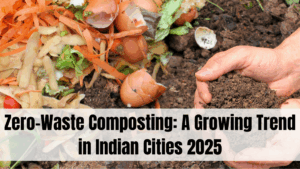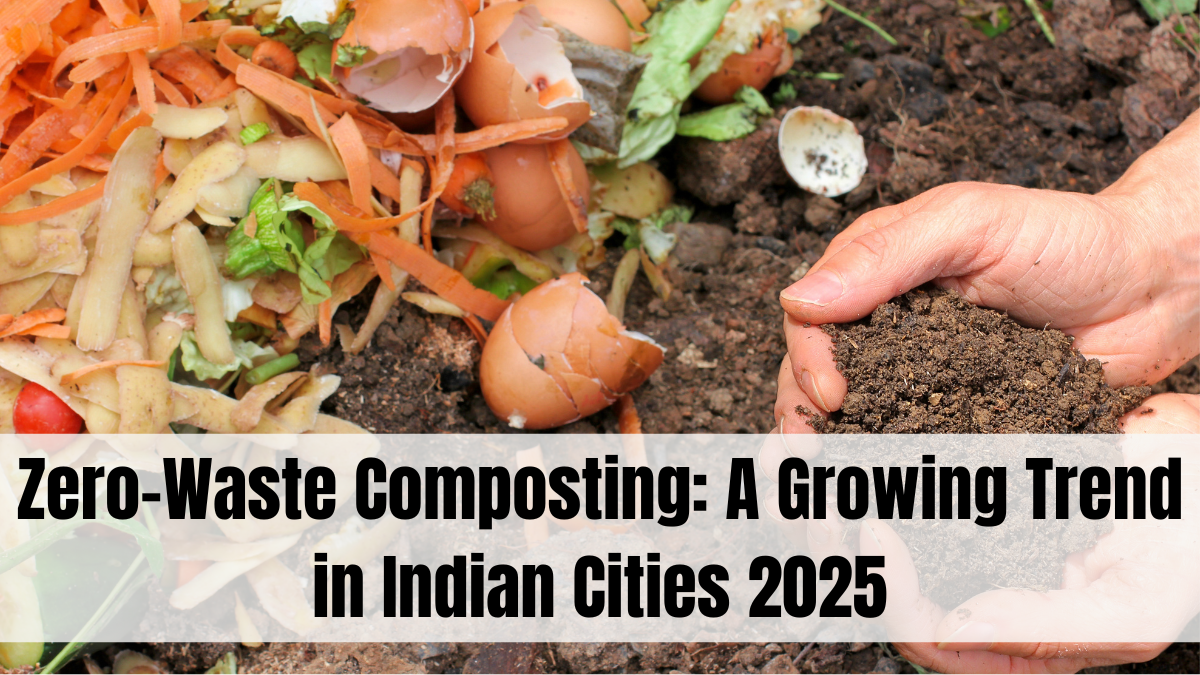As environmental awareness rises across India, home composting India 2025 has emerged as a practical, sustainable way for urban households to reduce waste and nurture healthier soils. With growing concerns about landfill overflow and organic waste management, many city residents are adopting do-it-yourself (DIY) composting methods that turn kitchen scraps and garden waste into valuable fertilizer.
This guide explains the basics of home composting, step-by-step processes, best practices, benefits, and tips specifically tailored for beginners in Indian urban settings.

What Is Home Composting and Why Is It Important?
Home composting is the biological decomposition of organic waste—like vegetable peels, fruit scraps, leaves, and paper—into nutrient-rich humus that can be used to enrich soil. Unlike dumping organic waste into landfills where it produces methane, composting helps reduce greenhouse gas emissions and diverts waste from overcrowded waste systems.
For Indian city dwellers, home composting:
-
Minimizes household garbage volume.
-
Cuts down on municipal waste processing costs.
-
Provides a free, organic fertilizer for gardens and plants.
-
Supports sustainable urban gardening and greenery.
-
Enhances soil fertility and moisture retention.
Adopting composting in 2025 aligns with India’s sustainability goals and enhances local environmental quality.
Simple DIY Composting Methods for Urban Homes
Several composting approaches fit urban Indian lifestyles, including:
-
Traditional Pit Composting: Dig a small pit or use a container to layer organic waste with soil and let it decompose. Suitable for houses with small yards or balconies.
-
Vermicomposting: Use earthworms to accelerate decomposition in bins. It’s highly efficient and produces nutrient-rich worm castings. Compact bins work well in apartments.
-
Bucket Composting: Use sealed buckets with aeration holes to compost kitchen scraps indoors. This is odor-free and easy for beginners.
-
Compost Tumblers: Rotatable containers that speed up the process by easy turning, popular for terrace gardens.
-
Bokashi Composting: A fermentation method using microbial inoculants, suitable for urban settings with limited space.
Each method varies in space requirements, time, and maintenance, so choose what suits your home best.
Step-by-Step Guide to Start Composting at Home
-
Choose a Composting Method: Select based on space, waste quantity, and preference.
-
Collect Organic Waste: Include fruit and vegetable scraps, coffee grounds, tea leaves, eggshells, dry leaves, and paper scraps. Avoid meats, dairy, and oily foods to prevent pests and odors.
-
Prepare the Compost Bin: Ensure proper drainage and aeration for microbial activity.
-
Layer Waste Properly: Alternate green (nitrogen-rich) and brown (carbon-rich) materials to balance decomposition.
-
Maintain Moisture: Keep compost damp like a wrung-out sponge. Water occasionally if dry.
-
Aerate Regularly: Turn the compost every few days to supply oxygen for microbes.
-
Monitor and Harvest: Compost will mature in 2–4 months. It’s ready when dark, crumbly, and earthy-smelling.
Following these steps will create rich compost ideal for plants and gardens.
Benefits of Home Composting for Indian Urban Residents
-
Waste Reduction: Significant cut in organic waste sent to landfills, easing urban sanitation challenges.
-
Cost Savings: Reduces need to buy chemical fertilizers or garden soil enhancers.
-
Environmental Protection: Lowers methane emissions and improves urban air quality.
-
Healthy Gardening: Compost improves soil structure, nutrient content, and water retention, benefiting plants.
-
Educational Value: Encourages eco-consciousness among family members, especially children.
Home composting fosters a direct connection between consumers and nature, even in cities.
Practical Tips and Common Challenges
-
Pest Prevention: Use sealed bins and avoid meat or oily waste to deter rodents and insects.
-
Odor Control: Proper aeration and carbon-rich materials help maintain neutral smell.
-
Space Management: Use vertical or balcony composting kits for limited spaces.
-
Seasonal Adjustments: In rainy seasons, cover compost bins; in summers, monitor moisture closely.
-
Patience: Composting takes time; regular maintenance accelerates the process.
Overcoming these common hurdles ensures a successful composting journey.
Government and Community Support in India
-
Several municipal corporations promote composting via workshops and subsidies on compost bins.
-
NGOs and urban farming groups organize awareness drives and provide training for beginners.
-
Government policies increasingly encourage organic waste segregation at source, supporting composting efforts.
Engaging with these initiatives helps access resources and build community support.
Future Outlook of Urban Composting in India
-
Integration of smart sensors to monitor moisture, temperature, and decomposition stages.
-
Development of compact, odor-free automated composters suited for apartments.
-
Increased collaboration between citizen groups and municipalities for large-scale organic waste recycling.
-
Expansion of composting culture as part of broader zero-waste urban living movements.
Composting will continue evolving as a cornerstone of sustainable Indian urban lifestyles.
FAQs
What kitchen waste can I compost at home?
Vegetable and fruit scraps, coffee grounds, tea leaves, eggshells, dry leaves, shredded paper.
How long does home composting take?
Typically 2 to 4 months depending on method, temperature, and maintenance.
Can I compost in an apartment without a garden?
Yes, vermicomposting and bucket composting are ideal for small indoor spaces.
How do I prevent bad smells during composting?
Maintain balance of green and brown materials, aerate regularly, avoid meat/dairy waste.
Is compost safe for all plants?
Yes, it enriches soil naturally and can be used for vegetables, flowers, and indoor plants.
Click here to know more.
